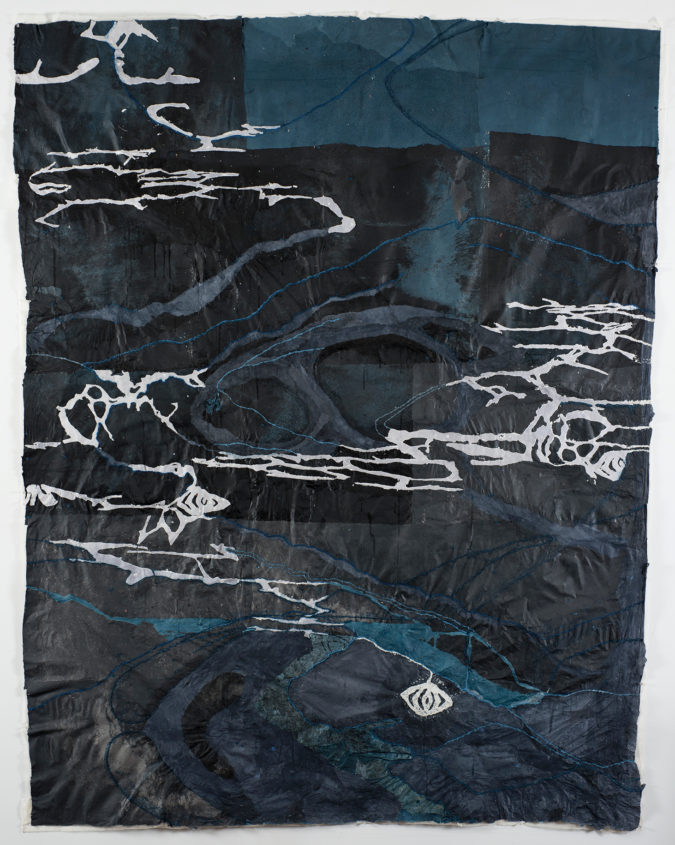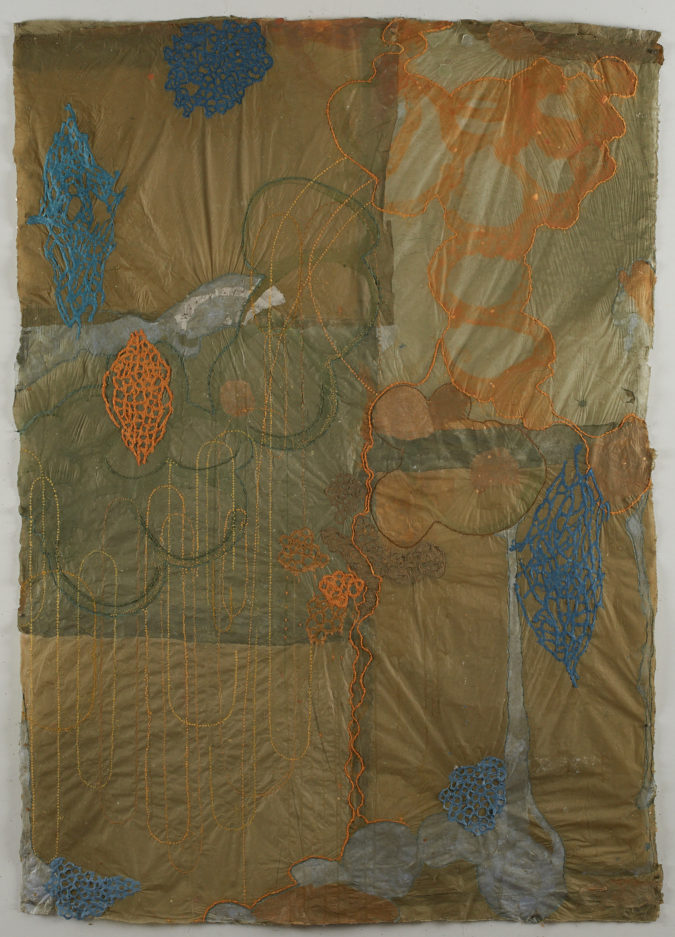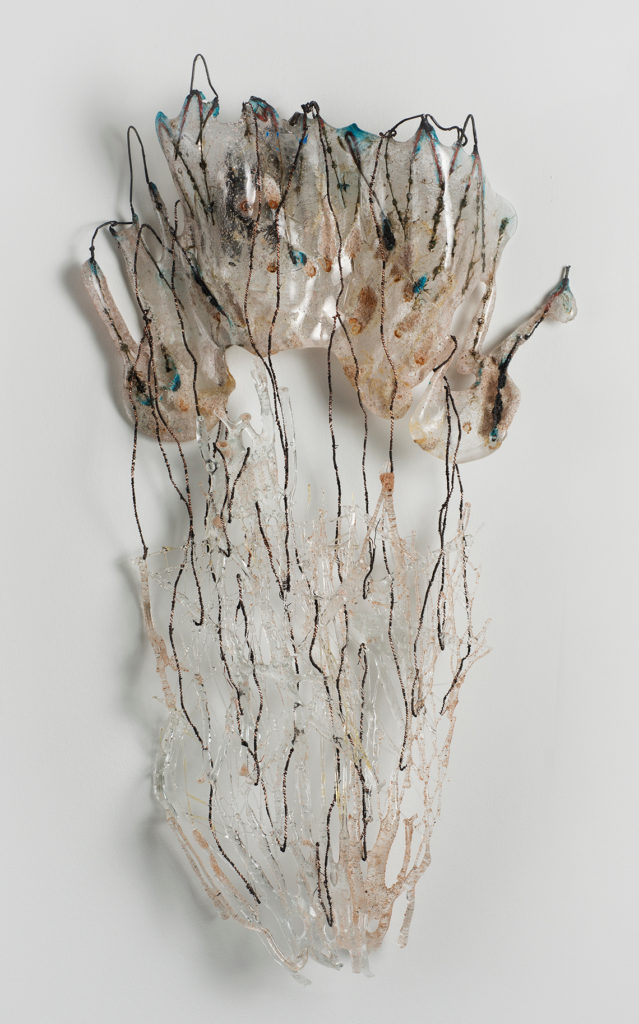Nancy Cohen
Jersey City based artist Nancy Cohen’s work examines resiliency in relation to the environment and the human body. Recent exhibitions include a solo show at Kathryn Markel Fine Arts, and group shows at Accola Griefen, BioBAT, Dorsky Gallery and The Montclair Museum. Awards include five fellowships from the NJ State Council on the Arts, two from the Brodsky Center, and a Pollock Krasner Foundation Grant. Residencies include the MacDowell Colony, Yaddo, The Millay Colony, Dieu Donne, Pilchuck Glass School, The Corning Museum, Bullseye Glass, and The Tides Institute. Current work has been featured in the blogs Artists and Climate Change, Art Spiel and Less than Half, in the anthology the Body in Language edited by Edwin Torres and in ArtTable’s Artist Perspective Podcast. In 2021 she will have an NEA Studio Residency at Women’s Studio Workshop and a solo exhibition of large-scale paper works at The Visual Arts Center of NJ.
QUESTION:
Both your paper pieces and your sculptures are assembled from parts that you have created. Your process could be seen in the tradition of assemblage, but with a difference. Having seen you in the paper making studio it looks like you intend to make an artwork using an improvisatory, experimental approach. Sometimes one of these is a finished piece but more often it will become the ground for another work of art. It is as if you are using your own art as a raw material. A similar approach is apparent in the 3D glass sculpture. Each part is made intentionally as a possible sculpture. I picture the “leftovers” fallow on the shelves in your studio until they are ripe for finishing a piece. Your creative recursion appears analogous to the multiple processes of growth and decay which produce the richness of the natural world. But is your process recursive, repeating your method until a piece is solved? Or is it a cannibalism, consuming one creative result with another creative attempt? Or are you collaborating with yourself using multiple creative approaches? Do you have another take on using an artwork as the material for another artwork? Does your method reflect your involvement with the natural environment as I suggest or am I straining the analogy?
ANSWER:
The day we were at Dieu Donné I came in with a bag of ropes thinking of underwater roots and suspended vines I’d seen kayaking through Mangrove forests. The memory of a place or experience is often the springboard for my paper work, focusing the palette and approach to form. Once the paper is made, it’s a back and forth between working with a plan, and intuitively responding to what’s in front of me. The large paper pieces transform repeatedly over months of work.
The sculptures more typically begin with a physical feeling that I can pantomime in a gesture more easily than I can describe in words. In searching for forms to make this concrete, I make variations of elements. This does leave leftovers.
With glass components, there’s also the fact that the kiln needs to be filled, which leads to experimentation; as long as I have space, I wonder what would happen if I put this wire or powder or object in that bottle at this temperature. Some results go straight to the trash, others get re-melted into another idea, and the good ones join the piles that you are correctly imagining stacked up on my studio shelves.
Over time it has become important to make the materials for my work. It isn’t cannibalizing, as you wondered, since the initial steps are rarely intended as finished work, and it isn’t about the value of labor, but more that I think with my hands. More importantly, engaging directly with all aspects of a drawing or a sculpture (concept, form, color, texture, etc.) from its inception feels logical to me. Ideas take shape as I make the paper or mix the pulp or twist the wire or cut the glass. Your comment about collaborating with myself was dead on. I need something to respond to and that seems to work best when I make everything myself.
My process is iterative, with each stage combining intention and improvisation, and with as much subtraction as addition. With the drawings it’s relatively easy to remove something that doesn’t feel right and torn paper is easily repaired; patching becomes part of the work. Sculpture is more difficult. Sometimes I can grind off a small joint; sometimes I need to whack off something with a hammer. If you’re thinking this sometimes leads to disasters, you’re right. Working on the edge of destruction to keeps things fresh keeps me open to change.
As to nature and how it relates to my work, I’m compelled by the fragility and resilience of the natural world, its intimacy and vastness, its disparate time scales, quick as the tides or slow as the transformation of a fresh water pond to a salt water marsh. I consciously research and physically explore natural environments, particularly waterways; it feeds the part of me that makes art.
During the pandemic I’ve been thinking about the ravages of nature: illness and death, leaving this world, and conversely being isolated and trapped, as we all are these days. These opposing feelings bring escape to mind. At the moment I have several tables filled with wing-like glass abstraction; the shapes speak to me, but I don’t yet know what they’re for.
In a larger sense, there’s something “natural” in both my way of working and what I’m aiming to produce with it. My way of making a sculpture or drawing is not from the process of growth and decay that you see in a forest or marsh; and I’m most excited by the result when it feels, as those natural environments do, both complete and dynamic. Nature works within itself, producing its own materials and ceaselessly reworking them; when things are going well for me, I’m doing something similar.









Thanks. Very intimate and informative question(s) and answer(s)
Nancy Cohen, never ceases to enlighten and amaze me. An inspiration and noteworthy artist.
I love the idea of collaborating with yourself! Very generative.
The combination of your pragmatism and spontaneous intuitive approach plus your willingness to accept/adapt to change is very unusual. I’m a big fan of your work!
Wonderful to read Nancys honest thoughtful descriptions of her process. Her work continues to evolve and reach for new insights and I’ve loved watching it change through the years. Great interview!
Really compelling description of your process!
Nancy, No matter how many times I look at your work, now over 25 years worth, I am still blown away by the ever changing, inventiveness of your form, material and color evolutions that make up your responses to the natural world and human life. And I always learn something new when I read your thoughts on your process. Can’t wait to see the new work in this daunting time.
Like Kristen, with whom I agree, I have been observing Nancy Cohen’s progression of work for more then 30 years. In the beginning of watching Nancy shift from one material to the next I have always had the sensation of holding my breath, with a sudden intake. The word that has always come to mind when seeing Nancy’s next piece or group of pieces remains the same…brave. NC is one hell of a warrior.
Hi Nancy
Your work is both elusive and captivating. Usually glass is seductive from it’s own composition. When I look at some of your glass pieces, I feel as if I am looking though–some kind of ghost vision, spiritual vision. Intriguing work.
Insightful observations and questions. Nancy’s answers gave me greater understanding about her development of a practice that relies on process, how making, thinking, and the formation of visual ideas evolve simultaneously in mid-stream.